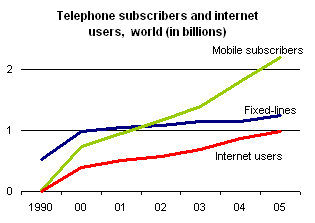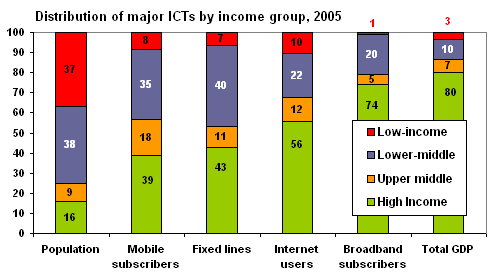Target 18: In cooperation with the private sector,
make available the benefits of new technologies, especially information
and communications, Indicators 47-48
Main
(fixed) telephone lines, mobile cellular subscribers, and Internet users
(per 100 population)
Target 18 highlights the potentially positive impact
of new technologies and the need to spread access to information and
communication technologies (ICTs). ICTs hold great promises for social
and economic development and have been recognized as an engine for
economic growth and for delivering innovative applications in
government, commerce, education, and many other areas. They can further
help reduce major development concerns and contribute to the achievement
of social development goals, including the MDGs.
Over the last 15 years, access to ICTs has been growing at high speed,
always exceeding global economic growth. ICT growth has been driven by
both demand-side factors, such as the increasing popularity of mobile
phones and the internet, and by supply-side factors such as regulatory
reforms, falling costs, and technological innovation. Access to ICTs is
not evenly distributed, though, and there are major differences in
quantity and quality of telecommunication services, a situation that is
referred to as the digital divide. This divide has to be reduced
in order for all nations to effectively participate in and benefit from
the global information society.
Figure 1:
Growing, growing, growing…

Source: ITU World
Telecommunication/ICT Indicators Database. |
By
the end of 2005, the telecommunication industry had experienced
continuous growth, as well as rapid progress in policy and technology
development, resulting in an increasingly competitive and networked
world.
At
the end of 2005, there were 1.25 billion fixed telephone lines in
operation around the world, compared to 520 million in 1990 and close to
one billion by 2000. Access to fixed telephone networks almost doubled
from 10 subscribers per 100 inhabitants in 1990, to 19.4 in 2005 but
fixed line growth has been slowing down. The number of fixed lines has
grown by some five per cent over the five-year period between the year
2000 and 2005.
Growth has been strongest in the mobile sector. From just 11 million
subscribers in 1990, the number of mobile cellular subscribers grew
to 2.2 billion by the end of 2005. This represents an annual average
growth rate of over 40 per cent, compared to just six per cent for fixed
telephone line subscribers over the same period. One factor contributing
to the rapid growth in mobile cellular was the introduction of
second-generation (2G) digital systems, launched in the early-1990s and
the high degree of competition in the sector. The number of mobile
subscribers overtook the number of fixed telephone lines in 2002 and by
the end of 2005, more than one out of three people around the world had
a mobile phone, up from one in 339 in 1991.
In 2005 alone,
the world’s mobile subscriber base increased by 22 per cent, and reached
a penetration rate of 34 percent at the end of 2005. After the success
of 2G, more and more operators have launched IMT-2000 (3G) mobile
services, which promise extended services and opportunities, including
internet access. However, today still the large majority of high speed
mobile network subscribers are located in the developed world.
Mobile growth has been
particularly robust in Africa, a continent that has been struggling to
get connected and where almost all countries today have more mobile than
fixed telephone subscribers. In 2005
alone, the African continent added almost 60 million new mobile
cellular subscribers to its subscriber base,
a figure equivalent to the total number of (fixed and mobile) telephone
subscribers on the continent in 2002, just three years earlier. By 2005,
mobile penetration had reached 15 per cent, five times the fixed rate.
It is obvious that mobile has been critical for enhancing access to
telecommunications in a region where fixed lines remain very limited.
While on average there are only three fixed lines for 100 Africans, the
rate is even lower in Sub-Sahara Africa, where it stands at 1 to one
hundred. As a whole, developing countries now account for 62 per cent of
all (fixed and mobile) telephone subscribers in the world, up from just
19 per cent in 1990.
The number of
internet users continues to grow, reaching close to one billion
worldwide at the end of 2005, compared to just under 400 million
five years earlier, in 2000. Internet user penetration rates continue to
vary greatly, though, with over 50 percent of the population in
developed countries online, compared to only nine percent in the
developing countries. In Africa, still only four percent of the
population was estimated to be using the internet.
A
major divide has also developed in the area of broadband, or high-speed,
Internet access.
High-speed
internet access is significantly changing the internet experience and
broadband internet access technologies (e.g. xDSL, cable modems,
wireless LANs, fibre optics) are extending access and improving its
quality. Many developing countries have so far missed out on the
broadband boom, though, and by the end of 2005, almost three-quarters of
all broadband subscribers worldwide were located in high-income
countries. Advanced wireless broadband technologies, such as wireless
metropolitan area networks (e.g. WiMAX), might offer great promise to
enable developing countries to achieve greater internet penetration
rates, at higher speeds. ITU estimates that the number of broadband
internet users stood at around 181 million at the end of 2005, compared
to 159 million a year before. Although wireless technologies hold great
promises for internet access, particularly in regions that have been
difficult to connect, it is still unclear when and to what extend mobile
broadband technologies will actually help more developing countries, and
particularly the poorest, to connect to the internet - and to the
information society.
Figure 2: 2005 worldwide
distribution of ICTs by income levels

Source: ITU World
Telecommunication/ICT Indicators Database.
Note: GDP data refer to end 2004. Income levels refer
to the World Bank classification. |
This overview highlights that it is true and encouraging that in the
telecommunication/ICT sector significant progress has been made across
almost all economies and regions worldwide (Figure 1). At the same time,
major differences remain, between developed and developing countries,
and on a regional basis (Table 1).
The
extent of the digital divide is further illustrated in Figure 2, which
looks at disparities in ICTs in terms of income levels. It is not a
surprise that there is a link between income levels and development,
including in the area of ICTs. This chart shows that high-income
economies represent less than 16 per cent of world population, but
account for almost 80 per cent of global wealth. Low-income economies
account for over a third of world population, but only 3 per cent of
wealth. Inequality in the distribution of ICTs is not as great as
inequality in the distribution of global wealth. Disparities are
smallest in the area of mobile subscribers, and greatest in the area of
broadband subscribers and internet users. Although low and lower-middle
income countries are home to 75 percent of the world’s population, they
represent only ten percent of the world’s internet users.
Table 1. Access to information and communication technologies,
1990 compared to 2005, various regions
| |
Main (fixed) telephone lines per 100
population |
Mobile cellular subscribers per 100
population |
Internet
users per 100 population |
| |
1990 |
2005 |
1990 |
2005 |
1990 |
2005 |
|
World |
9.9 |
19.4 |
0.2 |
34.1 |
0.3 |
15.3 |
|
Developed |
44.2 |
52.4 |
1.2 |
85.1 |
0.3 |
53.0 |
|
CIS |
12.4 |
23.1 |
0.0 |
55.0 |
0.0 |
11.9 |
|
Transition countries of
south-eastern Europe |
13.8 |
24.3 |
0.0 |
62.1 |
0.0 |
18.8 |
|
Developing |
3.1 |
13.7 |
0.0 |
25.1 |
0.0 |
8.6 |
|
Northern Africa |
2.9 |
10.7 |
0.0 |
29.8 |
0.0 |
8.3 |
|
Sub-Saharan Africa |
1.0 |
1.5 |
0.0 |
12.4 |
0.0 |
2.8 |
|
Latin America and the Caribbean |
6.3 |
17.7 |
0.0 |
43.3 |
0.0 |
15.2 |
|
Eastern Asia |
2.4 |
27.7 |
0.0 |
33.2 |
0.0 |
11.7 |
|
South
Asia |
0.7 |
5.0 |
0.0 |
8.0 |
0.0 |
5.1 |
|
South-eastern Asia |
1.3 |
8.2 |
0.1 |
25.9 |
0.0 |
9.2 |
|
Western Asia |
9.8 |
18.1 |
0.1 |
43.1 |
0.0 |
10.5 |
|
Oceania |
3.4 |
4.3 |
0.0 |
8.1 |
0.0 |
5.2 |
|
Least Developed Countries (LDCs) |
0.3 |
0.9 |
0.0 |
5.0 |
0.0 |
1.1 |
|
Landlocked Developing Countries
(LLDCs) |
2.3 |
3.0 |
0.0 |
6.8 |
0.0 |
1.7 |
|
Small Island Developing States
(SIDS) |
7.1 |
12.6 |
0.2 |
31.8 |
0.0 |
13.3 |
Source: ITU World
Telecommunication/ICT Indicators Database. |
The
availability of gender-disaggregated statistics for target 18 indicators
is limited. Data for the number of telephone subscribers and PCs come
from administrative and operational records, which do not disaggregate
the data by gender. In the case of internet users, surveys have been
conducted in a number of countries, providing a breakdown between males
and females. These surveys show a mixed picture, indicating that while
the proportion of female internet users is still lower than the
proportion of male Internet users in a number of countries, the trend
(where time-series data are available) is towards an increasing
proportion of female users over time. In some countries, there are
already more women online than men. However, it is important to note
that these survey results are not representative since they limited to
mainly highly developed countries.
There are methodological, quality and availability issues related to the
indicators used to measure Target 18. These concerns are minimal for the
number of telephone subscribers. The data for this indicator come from
administrative records compiled by national regulatory authorities or
telecommunication operators that tend to be timely and complete.
However, there are issues related to the practice of some countries
including a “virtual” number of telephone lines for high-speed data
services. There are also comparability issues for mobile subscribers due
to the prevalence of pre-paid subscriptions. These arise from
differences in the time period chosen for considering when a pre-paid
subscription is no longer active.
There are growing methodological issues in measuring the number of
internet users. These include wide variations in the definition of an
Internet user in terms of the user’s age and frequency of use. Another
emerging issue is how to treat Internet access from mobile phones. While
many developed nations now carry out Internet user surveys conducted by
national statistical offices or industry associations, only very few
developing countries do so. In the case of most developing nations,
internet users are calculated based on a multiplier factor of the number
of subscribers. When developing countries estimate the number of
Internet users, they also take into consideration that many users are
not subscribers and
obtain access through public facilities such as libraries, Internet
cafés and schools. ITU has been discussing possibilities to enhance the
capacity in developing nations to collect information and communication
technology indicators. One challenge will be to increase the number of
developing countries that carry out household and individual ICT
surveys. Since 2004, ITU, together with UNCTAD, OECD, World Bank, UNESCO
Institute of Statistics, Eurostat, four UN Regional Commissions (ECA,
ECLAC, ESCWA, ESCAP) has been working towards the improvement and
harmonization of international ICT data, through the
Partnership on Measuring ICT for Development.
This initiative will help develop a coherent and structured approach to
advancing the development of ICT indicators globally, and in particular
in developing countries.
|



